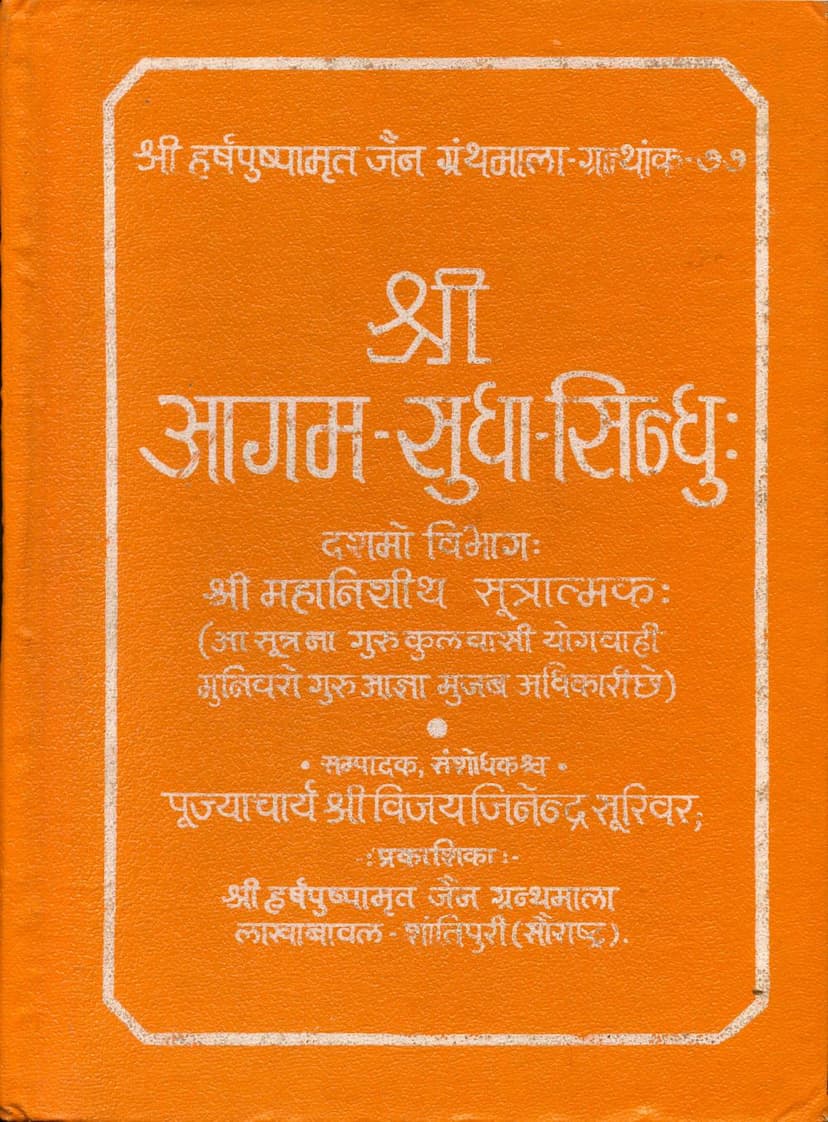Agam Sudha Sindhu Part 10
Added to library: September 1, 2025

Summary
This is a summary of "Agam Sudha Sindhu Part 10" by Jinendravijay Gani, published by Harshpushpamrut Jain Granthmala. The catalog link indicates it's related to the "Shri Mahanishitha Sutra".
Core Theme:
The text focuses on the Mahanishitha Sutra, a significant Jain scripture. The primary theme revolves around purification, adherence to Jain principles, and the consequences of deviating from them. A recurring concept is the idea of sallaha (salla) or "thorns," which symbolize impurities, negative karmas, and the attachments that bind the soul, hindering spiritual progress. The text emphasizes the importance of identifying, removing, and preventing these sallas through various means.
Key Concepts and Content:
- Salla Uddharan (Removal of Thorns): This is a central theme, explored extensively throughout the text. It refers to the process of purging oneself of the sallas that obstruct spiritual liberation. This involves a deep introspection into one's actions, thoughts, and speech.
- Types of Sallas: The text likely details various types of sallas, including those stemming from:
- Kashayas: Anger, pride, deceit, and greed.
- Indriyas: Overindulgence of the senses.
- Internal Defilements: Attachment, aversion, ego, and negative desires.
- External Actions: Improper conduct, breaking vows, and associating with those who are kusheel (unvirtuous).
- The Path to Salla Uddharan: The text outlines the methods for removing these sallas:
- Right Faith, Right Knowledge, Right Conduct (Samyak Darshan, Samyak Gyana, Samyak Charitra): These are presented as the fundamental pillars for spiritual progress and the removal of impurities.
- Austerities (Tapas): Various forms of penance and self-discipline are likely discussed as crucial for burning away karmic impurities.
- Vigilance and Self-Awareness: Constant introspection and awareness of one's actions and their underlying intentions are stressed.
- Pondering the Consequences: The text highlights the importance of reflecting on the suffering and negative rebirths that result from clinging to sallas.
- Seeking Guidance from Ascetics (Sadhus/Munis): The text emphasizes the role of spiritual guides in identifying and rectifying errors.
- Repentance and Expiation (Prayashchitta/Alochna): A significant portion likely deals with confession and seeking expiation for transgressions.
- The Role of the Mahanishitha Sutra: The text positions the Mahanishitha Sutra as a guide for understanding these principles and achieving spiritual purification. It's presented as a "nectar ocean of Agamas" (Agam Sudha Sindhu), implying its profound spiritual value.
- The Importance of Sins and Virtues: The text likely contrasts the consequences of sinful actions (papkarma) with virtuous deeds (sukarma), emphasizing how the former leads to suffering and the latter to spiritual advancement.
- Specific Examples and Illustrations: While the provided text is in Prakrit (and potentially some Sanskrit in the devotional verses), the summaries from page content suggest detailed discussions and illustrative stories. The repeated use of "Gothama" implies dialogues with Lord Mahavira.
- The Nature of the Soul: Underlying these discussions is the Jain concept of the soul's journey, its inherent purity, and how karmic impurities obscure its true nature.
- The ultimate Goal: The ultimate aim is to achieve liberation (moksha) from the cycle of birth and death by eradicating all impurities and realizing the soul's pure essence.
Structure and Presentation:
The text is presented as an "Adhyayana" (chapter) of the Mahanishitha Sutra. The content seems to be a discourse, possibly between Lord Mahavira and his disciple Gautama, explaining the principles of Jainism, particularly regarding spiritual purity and the removal of karmic obstacles. The devotional verses at the beginning and end likely invoke the blessings of Tirthankaras and spiritual preceptors.
In essence, "Agam Sudha Sindhu Part 10" appears to be a profound exploration of the path to spiritual liberation within Jainism, meticulously detailing the concept of karmic impurities and the systematic methods for their eradication as taught in the ancient Mahanishitha Sutra.